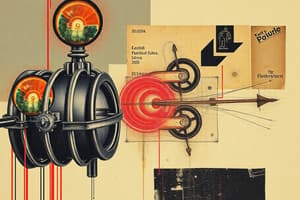Podcast
Questions and Answers
What is an induction motor?
What is an induction motor?
- A motor that uses electromagnetic induction from the stator winding to produce torque in the rotor without electrical connections. (correct)
- A motor that uses electromagnetic induction from the rotor to produce torque in the stator without electrical connections.
- A motor that uses permanent magnets to create torque in the rotor.
- A motor that uses direct current to create torque in the rotor.
What type of induction motors are commonly used in industrial drives?
What type of induction motors are commonly used in industrial drives?
- Single-phase squirrel-cage induction motors
- Three-phase squirrel-cage induction motors (correct)
- AC commutator-free polyphase induction motors
- Permanent magnet induction motors
How are induction motors increasingly being installed in variable-speed applications?
How are induction motors increasingly being installed in variable-speed applications?
- Using variable-frequency drives (VFD (correct)
- Using direct current drives
- Using split-phase drives
- Using permanent magnet drives
Who invented the first AC commutator-free polyphase induction motors?
Who invented the first AC commutator-free polyphase induction motors?
What is the essential character of induction motors?
What is the essential character of induction motors?
What is slip in an induction motor?
What is slip in an induction motor?
How can induction motors be reversed?
How can induction motors be reversed?
What is the efficiency range of induction motors?
What is the efficiency range of induction motors?
Flashcards are hidden until you start studying
Study Notes
- An induction motor uses electromagnetic induction from the stator winding to produce torque in the rotor without electrical connections.
- Three-phase squirrel-cage induction motors are commonly used in industrial drives, while single-phase induction motors are used for smaller loads.
- Induction motors are increasingly being installed in variable-speed applications using variable-frequency drives (VFD) for energy savings.
- The first primitive induction motor was demonstrated in 1879, and the first AC commutator-free polyphase induction motors were invented by Galileo Ferraris and Nikola Tesla in the late 1800s.
- Induction motors' essential character is that torque is created solely by induction instead of the rotor being separately excited as in synchronous or DC machines or being self-magnetized as in permanent magnet motors.
- An induction motor always operates slightly slower than synchronous speed due to slip.
- An induction motor can be used as an induction generator or a linear induction motor.
- An AC motor's synchronous speed is the rotation rate of the stator's magnetic field, and the number of magnetic poles is equal to the number of coil groups per phase.
- Slip is defined as the difference between synchronous speed and operating speed, expressed in rpm or percentage or ratio of synchronous speed.
- Slip increases enough to create sufficient torque to turn the load when the speed of the rotor drops below synchronous speed.Induction motors are powered by alternating current and consist of a stator and rotor. The stator produces a magnetic field that induces a current in the rotor, generating torque. The speed of the rotor is determined by the slip, which varies from zero at synchronous speed to 1 when the rotor is stalled. Various starting methods are available such as split-phase, shaded-pole, and polyphase. Polyphase motors have rotor bars shaped to give different speed-torque characteristics. Speed control can be achieved through resistance, cascade connection, or variable-frequency drives (VFDs). Induction motors can be reversed by swapping any two phase connections for three-phase motors and reversing the connections of the starting winding for single-phase motors. Power factor can be improved by connecting capacitors. The efficiency of induction motors is around 85-97%. The Steinmetz equivalent circuit is a mathematical model used to describe how an induction motor's electrical input is transformed into useful mechanical energy output.- The Steinmetz equivalent circuit is a simplified model of an induction motor.
- The circuit consists of components for the stator winding, rotor winding, and transformer.
- The rotor components can be referred to the stator side of the circuit.
- The circuit can be used to approximate the behavior of an induction motor.
- Linear induction motors use the same principles as rotary induction motors but produce straight line motion.
- Applications of linear induction motors include magnetic levitation and linear propulsion.
- No additional notes or references are provided.
- No external links are provided.
Studying That Suits You
Use AI to generate personalized quizzes and flashcards to suit your learning preferences.



